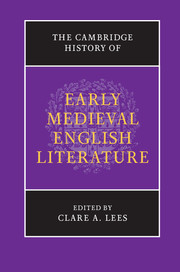Book contents
- Frontmatter
- Contents
- List of Illustrations
- List of Contributors
- Acknowledgements
- List of Abbreviations
- Introduction: literature in Britain and Ireland to 1150
- I WORD, SCRIPT AND IMAGE
- II EARLY ENGLISH LITERATURE
- 7 Across borders: Anglo-Saxon England and the Germanic world
- 8 English literature in the ninth century
- 9 The writing of history in the early Middle Ages: the Anglo-Saxon Chronicle in context
- 10 The literary languages of Old English: words, styles, voices
- 11 Old English poetic form: genre, style, prosody
- 12 Beowulf: a poem in our time
- 13 Old English lyrics: a poetics of experience
- 14 Literature in pieces: female sanctity and the relics of early women’s writing
- 15 Saintly lives: friendship, kinship, gender and sexuality
- 16 Sacred history and Old English religious poetry
- 17 Performing Christianity: liturgical and devotional writing
- 18 Riddles, wonder and responsiveness in Anglo-Saxon literature
- III LATIN LEARNING AND THE LITERARY VERNACULARS
- Bibliography
- Index of manuscripts
- Index
- References
14 - Literature in pieces: female sanctity and the relics of early women’s writing
from II - EARLY ENGLISH LITERATURE
Published online by Cambridge University Press: 05 February 2013
- Frontmatter
- Contents
- List of Illustrations
- List of Contributors
- Acknowledgements
- List of Abbreviations
- Introduction: literature in Britain and Ireland to 1150
- I WORD, SCRIPT AND IMAGE
- II EARLY ENGLISH LITERATURE
- 7 Across borders: Anglo-Saxon England and the Germanic world
- 8 English literature in the ninth century
- 9 The writing of history in the early Middle Ages: the Anglo-Saxon Chronicle in context
- 10 The literary languages of Old English: words, styles, voices
- 11 Old English poetic form: genre, style, prosody
- 12 Beowulf: a poem in our time
- 13 Old English lyrics: a poetics of experience
- 14 Literature in pieces: female sanctity and the relics of early women’s writing
- 15 Saintly lives: friendship, kinship, gender and sexuality
- 16 Sacred history and Old English religious poetry
- 17 Performing Christianity: liturgical and devotional writing
- 18 Riddles, wonder and responsiveness in Anglo-Saxon literature
- III LATIN LEARNING AND THE LITERARY VERNACULARS
- Bibliography
- Index of manuscripts
- Index
- References
Summary
Credimus autem multo plura quam reperiantur extitisse, que aut ex illius eui torpentium scriptorum negligentia nequaquam litteris mandata fuerunt, aut descripta paganorum rabie ecclesias ac cenobia depopulante inter cetera perierunt.
Goscelin of Saint-Bertin, Miracvla sancte Ætheldrethe[And we believe that there are many more (miracles) than are now to be found, which through the carelessness of the sluggish scribes of that age were never committed to writing, or were recorded but have perished among other things when the fury of the heathen laid waste to churches and monasteries.]
It is the sound of memory at work, creating a necklace of narrative.
Jane Urquhart, The Underpainter, p. 9Women’s literary historiography
Literary histories of English women’s writing have, traditionally, had little time for the early medieval period. Early medieval women are excluded from teleologies that celebrate the emergence of authorship and literature, understood in specific and restrictive terms, and that only acknowledge certain narrowly defined forms of textual production. They are omitted from linear temporal paradigms that already struggle to accommodate the vernacular visionary writings of the later medieval period and the devout poetry of the Renaissance, but which incorporate far more easily the dramatic texts of the seventeenth century and the prose writings of the eighteenth and nineteenth. One example of such an exclusive literary history is The Norton Anthology of Literature by Women: The Traditions in English, edited by Sandra M. Gilbert and Susan Gubar, now in its third edition (2007).
- Type
- Chapter
- Information
- The Cambridge History of Early Medieval English Literature , pp. 357 - 380Publisher: Cambridge University PressPrint publication year: 2012
References
- 4
- Cited by



